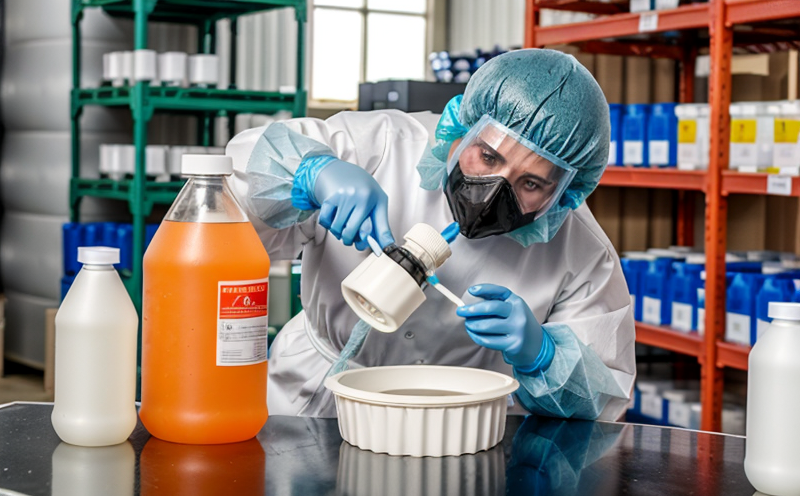ISO 13485 Microbiological Quality Testing in Medical Packaging
The ISO 13485 standard is a cornerstone for medical device manufacturers aiming to ensure the quality and safety of their products. This internationally recognized standard focuses on processes, system integration, and documentation. In the context of medical packaging materials, microbiological testing plays an essential role in ensuring that the packaging not only protects the product but also maintains its sterility and integrity throughout the supply chain.
The ISO 13485:2016 standard emphasizes the importance of quality management systems (QMS) for medical device manufacturers. Microbiological safety testing is a critical component of this QMS, ensuring that packaging materials do not introduce or harbor microorganisms that could compromise the sterility of the product. The testing process involves several steps, including specimen preparation and inoculation with specific organisms to assess the material's resistance.
The standard specifies that medical device manufacturers must conduct microbiological safety tests according to ISO standards such as ISO 11795-1:2009 for biological indicators and ISO 11795-2:2006 for chemical indicators. These tests are designed to evaluate the packaging's ability to maintain sterility under worst-case conditions.
During testing, samples of the medical device packaging are exposed to various microbial challenges, including spores, bacteria, and fungi, depending on the materials used in the product design. The performance of the packaging is then evaluated based on its resistance to microbial ingress, which can compromise the sterility of the packaged item.
The test results provide critical data that helps manufacturers ensure compliance with regulatory requirements, such as those set by the US Food and Drug Administration (FDA) or similar bodies in other regions. This testing is not only a legal requirement but also a vital step in maintaining patient safety.
In summary, ISO 13485 microbiological quality testing ensures that medical packaging maintains its sterility throughout the supply chain. By adhering to this standard, manufacturers can demonstrate their commitment to producing safe and reliable products, thereby fostering trust with healthcare providers and patients.
Why It Matters
The microbiological safety of medical packaging is critical in preventing contamination that could lead to product spoilage or, worse, patient infections. Infections caused by contaminated devices can have severe health implications, including sepsis and death.
- Reduces Risk of Contamination: Proper testing ensures that the packaging material does not introduce or harbor microorganisms that could compromise product sterility.
- Patient Safety: Ensuring that medical devices are free from microbial contamination is paramount to patient safety. Contaminated devices can lead to infections, which can be life-threatening.
The importance of microbiological testing cannot be overstated. By adhering to the ISO 13485 standard and conducting rigorous tests, manufacturers can demonstrate their commitment to quality and patient safety. This is especially critical in the medical device industry, where even minor lapses can have serious consequences.
Moreover, compliance with these standards helps manufacturers meet regulatory requirements set by various governing bodies around the world. This ensures that products are not only safe but also reliable and effective.
Scope and Methodology
The scope of ISO 13485 microbiological quality testing in medical packaging involves assessing the ability of the packaging material to maintain sterility under worst-case conditions. This includes evaluating the material's resistance to microbial ingress, which can compromise the sterility of the packaged item.
The methodology for conducting these tests is outlined in ISO standards such as ISO 11795-1:2009 and ISO 11795-2:2006. These standards provide detailed protocols for testing both biological indicators (BI) and chemical indicators (CI), which are used to simulate the presence of microorganisms.
During the test, samples of the medical device packaging are exposed to various microbial challenges, including spores, bacteria, and fungi, depending on the materials used in the product design. The performance of the packaging is then evaluated based on its resistance to microbial ingress.
The testing process involves several steps:
- Sample Preparation: Packaging samples are prepared according to the specified protocol, ensuring that they are representative of real-world conditions.
- Inoculation: Samples are inoculated with specific organisms designed to simulate worst-case scenarios for microbial ingress.
- Culturing and Incubation: The samples are incubated under controlled conditions, allowing any potential microorganisms to grow.
- Evaluation: The performance of the packaging is evaluated based on its resistance to microbial ingress. This can include visual inspection, microbiological analysis, or other relevant tests.
The results of these tests provide critical data that helps manufacturers ensure compliance with regulatory requirements and maintain patient safety.
Benefits
- Enhanced Patient Safety: By ensuring the sterility of medical devices, microbiological testing reduces the risk of infections and other complications for patients.
- Compliance with Regulations: Adhering to ISO standards helps manufacturers meet regulatory requirements set by various governing bodies around the world.
- Improved Product Quality: The rigorous testing process ensures that medical packaging maintains its integrity and sterility throughout the supply chain.
The benefits of ISO 13485 microbiological quality testing in medical packaging are manifold. Not only does it enhance patient safety, but it also helps ensure compliance with regulations and improves product quality. These tests are a critical step in ensuring that medical devices remain safe and effective throughout their lifecycle.
By investing in thorough microbiological testing, manufacturers can demonstrate their commitment to quality and patient safety, thereby building trust with healthcare providers and patients.





